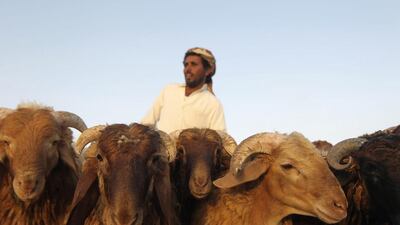Every Eid Al Adha, Saudi officials overseeing the Haj are presented with a daunting question.
What to do with all this meat?
More than 1 million animals are expected to be sacrificed during the Haj, providing more lamb, beef and camel meat than the 1.5 million pilgrims who have journeyed to Mecca can possibly eat.
Not so long ago, this abundance created a problem. The meat from hundreds of thousands of animals would be burnt or buried to reduce the surplus and not least, to prevent a sanitation crisis.
Authorities in the kingdom, however, have worked for the past three decades to build a system that avoids such waste and helps meet the religious obligation to distribute one-third of all meat prepared for the occasion to the poor. Now, excess meat is frozen and shipped overseas.
With the cooperation of Islamic banks and a legion of butchers, this flash-frozen meat will be shipped to impoverished Muslims in more than two dozen countries.
This year, Syria is also set to receive a large donation from the so-called Saudi Project for the Utilisation of Hajj Meat, also known as the Adahi programme, first launched 32 years ago.
“The act of sacrifice means doing something for someone else,” said Sayyid M Rizvi, a Toronto-based imam who has written books about the history of Islamic customs including Haj.
Flash-freezing meat, he said, is a way “to implement the rationale of this sacrifice — they make the facilities to preserve the meat and then to give it away to the poor segments of the Muslim world”.
Pilgrims can perform the sacrifice on any of three days of Eid Al Adha, which began yesterday. But most choose the first day, when they are in Mina just after they have thrown 49 pebbles at the jamarat pillars, symbolising the stoning of the devil.
In the early 1980s, demand for the meat from a growing number of pilgrims far outstripped the capacity of the five slaughterhouses in Mina.
“During the times of sacrifice, the crush of pilgrims near the premises of the slaughterhouses creates conditions approaching chaos,” wrote the US geographer Clarke Brooke in 1987 in a study of the Haj sacrifice. “Everywhere around the slaughterhouses are pilgrims, traders, live animals, and the carcasses of those already slain.”
Nor could pilgrims’ appetites match the quantity of meat slaughtered. Bulldozers pushed remains of animals into ditches; other carcasses were burnt.
“For years, hundreds of thousands of sheep were slaughtered, and after families took what they could use, the rest was simply buried because of the lack of processing facilities for sheep sacrificed one day of the year”, the retired US State Department official David E Long said in an interview with the Saudi-US Relations Information Service this week.
In 1983, the Islamic Development Bank (IDB) stepped in. The key to their plan was what the programme now calls “power of attorney to the slaughter of sheep”, freeing pilgrims of the physical need to carry out or be present for the slaughter.
“Sharia permits the Muslim to slaughter his offering by proxy given to any trusted person or entity,” Adahi’s website explains. “The Project acts as an agent to pilgrims”.
Instead of haggling for an animal, or waiting in long queues for a butcher in Mina, pilgrims can purchase coupons from Saudi banks and post offices, indicating which animal should be sacrificed and when. Prices are fixed each year.
As the system has grown — and online purchases have also become available — Saudi authorities invested massively on infrastructure to keep up with demand. Last year, the IDB said the kingdom had spent 1 billion Saudi riyals (Dh980m) to build new slaughterhouses, hire 700 veterinarians, and 400 religious experts.
“We deploy about 40,000 workers including veterinarians, administrators and butchers, to carry out the project every year,” the IDB president, Ahmed Mohamed Ali, said.
The programme distributed 993,000 animals to 24 countries after last year’s Haj. This year, the IDB is aiming to send even more meat to 28 countries. Mr Ali said he expected 1 million sheep, and 10,000 cattle and camels, to be slaughtered.
In Saudi Arabia, the Adahi project’s popularity has also inspired local businesses to get involved. About a decade ago, the Jeddah-based mufti Sheikh Nayeem Qasmi performed sacrifices of goats for friends as recompense for errors made during their pilgrimages.
“A few of my friends who know I do this service would contact me over the phone and then would have to send money so the goat could be slaughtered,” he said. Realising many people would be interested in services like this throughout the Haj and Umrah, he cofounded Hajj Solutions, which today makes sacrifices for on behalf of clients from 75 countries.
Just one in 10 pilgrims collects the meat from the animals he sells. “From the animals that are not collected, about 20 per cent are given to the poor people in Mecca and other local needy people,” he said. “The remaining is donated to the Adahi programme.”
The system is not without critics, however, particularly this year, as Saudi demand for cattle and sheep has pushed prices up elsewhere.
Adahi’s fixed price for sheep is 490 Saudi riyals (Dh480), less than a third of the Dh1,700 that buyers based in Abu Dhabi said they were paying for Gulf-raised sheep this week. Saudi customers are also paying more than pilgrims; the Saudi Gazette quoted customers yesterday putting the price for Gulf sheep at between 1,600 and 2,000 riyals.
This year, Saudi media has reported livestock imports from traditional trading partners Sudan, Somalia, Djibouti and Eritrea, but also Uruguay, Pakistan, Turkey and Australia.
At least some of that meat will likely head straight back to places such as Somalia and Pakistan, frozen and ready to consume.
edickinson@thenational.ae

